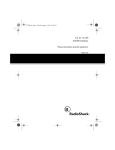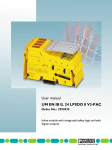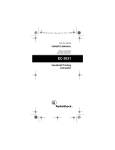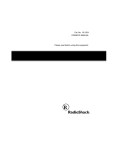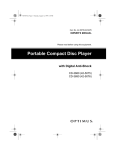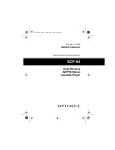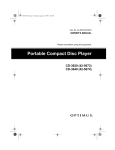Download Radio Shack voice activated Microcassette Recorder Owner`s manual
Transcript
14-1162.fm Page 1 Thursday, July 1, 1999 3:41 PM Cat. No. 14-1162 OWNER’S MANUAL Please read before using this equipment. Micro-35 Auto-Reverse Microcassette Tape Recorder 14-1162.fm Page 2 Thursday, July 1, 1999 3:41 PM FEATURES Your Optimus Micro-35 Auto-Reverse Microcassette Tape Recorder is ideal for quick note-taking. Its ultra-small size makes it easy to slip into a pocket or briefcase. You can use it at school, at business conferences, for dictation in the office, or anywhere on the go! You can turn on recording manually or set the recorder so sound activates recording. Your recorder includes these features: Voice-Activation Circuitry (VOX) — begins recording when the recorder picks up sound and stops a few seconds after the sound stops. Tape Counter with Reset Button — lets you mark the locations of certain sections of tape so you can easily return to them. Built-In Microphone and Speaker — let you record and play back notes anywhere. © 1997 Tandy Corporation. All Rights Reserved. Optimus is a registered trademark used by Tandy Corporation. RadioShack is a trademark used by Tandy Corporation. 2 14-1162.fm Page 3 Thursday, July 1, 1999 3:41 PM External Microphone Jack — lets you use an external microphone, so you can extend your recording range. Earphone Jack — lets you use an optional earphone to listen to a tape in privacy. Quick Record — lets you instantly change from playback to record. Tape Speed Switch — lets you record at normal or slow speed. Slow speed gives you twice the normal recording time. Fast Play — lets you play a tape back about 30% faster than normal speed, to save time when listening to a tape. Auto Reverse — automatically changes tape sides when the front side of the tape reaches the end during recording and playback. Auto Shut-Off — stops automatically when the tape reaches the end after playing both sides. 3 14-1162.fm Page 4 Thursday, July 1, 1999 3:41 PM Power Options — let you power the recorder from internal batteries, AC power (with an optional AC adapter), or vehicle battery power (with an optional DC adapter). We recommend you write your recorder’s serial number here. The number is inside the recorder’s battery compartment. Serial Number: 4 14-1162.fm Page 5 Thursday, July 1, 1999 3:41 PM CONTENTS Preparation ............................................ 6 Before You Begin.............................. 6 Connecting to Power ....................... 6 Using Batteries ......................... 7 Using AC Power ..................... 10 Using Vehicle Battery Power .. 12 Connecting an Earphone ............... 14 Listening Safely ...................... 15 Traffic Safety .......................... 15 Connecting an External Microphone......................................16 Operation ............................................. Loading a Microcassette Tape ....... Recording ...................................... Playing a Tape ............................... Using Fast-Forward/ Rewind ................................... Quick Record ................................. Using the Tape Counter ................. 17 17 19 23 Tape Tips ............................................. Storing Cassette Tapes ................. Preventing Accidental Erasure ...... Erasing a Cassette Tape ............... 27 27 27 28 24 25 26 Care ...................................................... 29 Cleaning the Tape-Handling Parts .............................................. 30 Specifications ..................................... 32 5 14-1162.fm Page 6 Thursday, July 1, 1999 3:41 PM PREPARATION BEFORE YOU BEGIN To protect the tape deck mechanism during shipment, a protective sleeve is inserted in the cassette compartment. Remove it before you use the Micro-35. To protect the Micro-35’s front panel during shipment, a piece of blue film covers the panel. Peel off this film before you use the Micro-35. CONNECTING TO POWER You can power your Micro-35 from any of the following: • Internal battery power • AC power (with an optional AC adapter) • Your vehicle’s battery (with an optional DC adapter) 6 14-1162.fm Page 7 Thursday, July 1, 1999 3:41 PM Using Batteries You can use two AA batteries (not supplied) to power your Micro-35. We recommend alkaline batteries, such as RadioShack Cat. No. 23-552. You can also use rechargeable nickel-cadmium batteries (Cat. No. 23-125) and a battery charger (Cat. No. 23-133), available at your local RadioShack store. Cautions: • Use only fresh batteries required size and type. of the • Never leave dead or weak batteries in the Micro-35. Batteries can leak chemicals that can destroy electronic circuits. • Do not mix old and new batteries, different types of batteries (standard, alkaline, or rechargeable), or rechargeable batteries of different capacities. • Dispose of old batteries promptly; do not bury or burn them. 7 14-1162.fm Page 8 Thursday, July 1, 1999 3:41 PM Follow these steps to install batteries. 1. Slide the battery compartment cover in the direction of the arrow until it stops, then lift up the cover. Caution: The battery compartment cover is attached to the recorder. Do not try to remove it. 2. Insert the batteries into the compartment as indicated by the polarity symbols (+ and –) marked inside the compartment. 3. While pressing down the battery compartment cover against the recorder, slide it in the opposite direction of the arrow to close it. 8 14-1162.fm Page 9 Thursday, July 1, 1999 3:41 PM Notes: • If the record/battery indicator to the right of the MIC jack does not light or lights dimly during manual recording, replace the batteries. • If you do not plan to use the Micro-35 for several days, or if you plan to use only AC or vehicle battery power, remove the batteries. Important: Your recorder is capable of using rechargeable nickel-cadmium batteries. At the end of the batteries’ useful life, they must be recycled or disposed of properly. Contact your local, county, or state hazardous waste management authorities for information on recycling or disposal programs in your area. Some options that might be available are: municipal curbside collection, drop-off boxes at retailers such as your local RadioShack store, recycling collection centers, and mailback programs. 9 14-1162.fm Page 10 Thursday, July 1, 1999 3:41 PM Using AC Power To power the Micro-35 from an AC outlet, you need an AC adapter (not supplied), such as Cat. No. 273-1654, and an EIAJ 2.35 mm outer diameter/0.7 mm inner diameter adapter barrel plug (not supplied), such as Cat. No. 273-1646. Cautions: • You must use an AC adapter that supplies 3 volts DC power and delivers at least 200 milliamps. The center tip of the adapter barrel plug must be set to positive, and the plug must properly fit the Micro-35’s DC3V jack. The recommended AC adapter and plug meet these specifications. Using an AC adapter and plug that do not meet these specifications could damage the Micro-35, the AC adapter, or the plug. • Always connect the AC adapter to the Micro-35 before you plug it into the AC outlet, and unplug the adapter from the AC outlet before you unplug it from the Micro-35. 10 14-1162.fm Page 11 Thursday, July 1, 1999 3:41 PM Follow these steps to power the Micro-35 from standard AC power. Rad ioSn ack 1. Set the AC adapter’s voltage switch to 3V. 2. Attach the barrel plug to the AC adapter’s cord with the tip set to positive (+). 3. Insert the barrel plug into the Micro35’s DC3V jack. This disconnects the internal batteries. 4. Plug the other end of the AC adapter into a standard AC outlet. 11 14-1162.fm Page 12 Thursday, July 1, 1999 3:41 PM Using Vehicle Battery Power To power the Micro-35 from your vehicle’s battery, you need a DC adapter (not supplied), such as Cat. No. 273-1801. Cautions: • You must use a DC adapter that supplies 3 volts DC power and delivers at least 200 milliamps. The center tip of its barrel plug must be set to positive, and the plug must properly fit the Micro-35’s DC3V jack. The recommended DC adapter meets these specifications. Using a DC adapter that does not meet these specifications could damage the Micro-35 or the DC adapter. • Always plug the DC adapter into the Micro-35 before you plug it into the cigarette-lighter socket, and unplug the adapter from the cigarette-lighter socket before you unplug it from the Micro-35. 12 14-1162.fm Page 13 Thursday, July 1, 1999 3:41 PM Follow these steps to power the Micro-35 from your vehicle’s battery. 1. Set the DC adapter’s voltage switch to 3V. 2. Attach the 2.35 mm outer diameter/0.7 mm inner diameter barrel plug with the tip set to positive (+). 3. Insert the barrel plug into the Micro35’s DC3V jack. This disconnects the internal batteries. 4. Plug the other end of the DC adapter into the vehicle’s cigarette-lighter socket. 13 14-1162.fm Page 14 Thursday, July 1, 1999 3:41 PM CONNECTING AN EARPHONE You can use an optional earphone with a 3/32-inch plug to listen to a tape in privacy. Notes: • You can also use an earphone to listen to what the recorder picks up through the internal microphone or an external microphone. • Your local RadioShack store carries a wide selection of earphones. Insert the earphone’s plug into the recorder’s EAR jack. The built-in speaker automatically disconnects. MICRO-35 MICROCASSETTE RECORDER EAR TION VOICE ACTIVA 14 14-1162.fm Page 15 Thursday, July 1, 1999 3:41 PM Listening Safely To protect your hearing, follow these guidelines when you use an earphone. • Set the volume to the lowest setting before you begin listening. After you begin listening, adjust the volume to a comfortable listening level. • Do not listen at extremely high volume levels. Extended high-volume listening can lead to permanent hearing loss. • Once you set the volume, do not increase it. Over time, your ears adapt to the volume level, so a volume level that does not cause discomfort might still damage your hearing. Traffic Safety Do not wear an earphone while operating a motor vehicle or riding a bicycle. This can create a traffic hazard and could be illegal in some areas. Even though some earphones let you hear outside sounds when listening at normal volume levels, they still can present a traffic hazard. 15 14-1162.fm Page 16 Thursday, July 1, 1999 3:41 PM CONNECTING AN EXTERNAL MICROPHONE You can use an optional microphone with a 3/32-inch plug to extend your recording range. Your local RadioShack store carries a wide selection of microphones. Insert the microphone’s plug into the recorder’s MIC jack. The built-in microphone automatically disconnects. MICRO-35 MICROCASSETTE RECORDER MIC TION VOICE ACTIVA 16 14-1162.fm Page 17 Thursday, July 1, 1999 3:41 PM OPERATION LOADING A MICROCASSETTE TAPE Note: We recommend MC-60 microcassette tapes for up to 2 hours of recording/ playback time, or MC-90 microcassette tapes for up to 3 hours of recording/playback time. Follow these steps to load a microcassette tape. 1. Use a pencil to turn the cassette’s hub and remove any tape slack. Avoid touching the tape. 17 14-1162.fm Page 18 Thursday, July 1, 1999 3:41 PM 5 MICROCASSETTE RECORDER 2. Press STOP/EJECT to open the cassette compartment door. Note: When you press STOP/EJECT, sREV/tFWD is automatically set to tFWD. See “Playing a Tape” on Page 23. VOICE ACTIVATION MICRO-35 MICROCASSETTE RECORDER 3. Insert the microcassette into the door’s guides so the microcassette’s open edge faces out. 4. Close the cassette compartment door. 18 14-1162.fm Page 19 Thursday, July 1, 1999 3:41 PM RECORDING You can record manually or use voice-activated recording. When you use the VOX feature, recording begins when the recorder picks up sound and stops a few seconds after the sound stops. Follow these steps to record. 1. Load the microcassette tape. 2. Set SPEED on the side of the recorder as follows: • To double the tape’s recording/playback time, set SPEED to 1.2. This setting allows 120 minutes total recording/playback time on an MC60 tape, or 180 minutes on an MC90 tape. 19 14-1162.fm Page 20 Thursday, July 1, 1999 3:41 PM • For better sound quality, set SPEED to 2.4. This setting allows 60 minutes total recording/playback time on an MC-60 tape, or 90 minutes on an MC-90 tape. 3. Set MICSENS/VOX as follows: • To manually start and stop recording, set MICSENS/VOX to MICSENS. • To use voice-activated recording, set MICSENS/VOX to VOX. Note: The voice-activated feature saves power and tape if there are long or frequent pauses in the material you are recording. 20 14-1162.fm Page 21 Thursday, July 1, 1999 3:41 PM ASSETTE RECORDER 4. Press both REC and PLAY to begin recording. Both buttons lock down, and the record/battery indicator to the right of the MIC jack lights. If MICSENS/VOX is set to MICSENS, recording begins immediately. If MICSENS/VOX is set to VOX, recording begins and the record/battery indicator lights steadily only when the recorder picks up sound. Caution: • To protect the recorder, press REC only when a microcassette tape is loaded. • Do not force down REC. If you cannot easily press REC , check the microcassette tape’s erase-protection tabs (see “Preventing Accidental Erasure” on Page 27). You cannot record on a microcassette tape if either of the erase-protection tabs is broken off. 21 14-1162.fm Page 22 Thursday, July 1, 1999 3:41 PM Note: To pause recording, slide PAUSE/OFF to PAUSE. To resume recording, slide PAUSE/OFF to OFF. 5. If you set MICSENS/VOX to VOX, adjust VOL to set the sound level at which recording begins. When you set VOL to higher settings, softer sounds start VOX recording. When you set VOL to lower settings, louder sounds start VOX recording. 6. Press STOP/EJECT to stop the tape. Note: The auto-reverse feature lets the Micro-35 automatically record both sides of a tape. When one side of the tape records to the end, the tape’s direction automatically reverses, and the tape’s other side records. At the end of the other side, the Micro-35 automatically stops. 22 14-1162.fm Page 23 Thursday, July 1, 1999 3:41 PM PLAYING A TAPE 1. Load the microcassette tape. 2. Set SPEED to the speed used when the tape was recorded. 3. To listen to the tape at normal speed, set NORMAL/F.PLAY to NORMAL. To listen to the tape at about 30% faster than normal, set NORMAL/ F.PLAY to F.PLAY. VOIC E AC TIV CROCASSETTE RECORDER 4. Press PLAY. 5. Adjust VOL to a comfortable listening level. 23 14-1162.fm Page 24 Thursday, July 1, 1999 3:41 PM 6. To reverse the tape’s direction so you can play the other side, switch sREV/ tFWD to the other position. 7. Press STOP/EJECT to stop playback. Note: The auto-reverse feature lets the Micro-35 automatically play both sides of a tape. When one side of the tape plays to the end, the tape’s direction automatically reverses, and the tape’s other side plays. At the end of the other side, the Micro-35 automatically stops. VO TTE RECORDER Using Fast-Forward/Rewind With REV/FWD set to tFWD, slide / to to rapidly rewind (review) a tape, or to to fast-forward (cue) a tape. (The directions are reversed if sREV/ tFWD is set to sREV.) 24 14-1162.fm Page 25 Thursday, July 1, 1999 3:41 PM If you slide / during playback, you can hear the tape at a faster speed as it cues or reviews. When you release / , the recorder resumes normal playback. If you slide / when the tape is stopped, the button locks. The tape fastforwards or rewinds until you slide / to the center position. Note: When the tape reaches the end during fast-forward and rewind, you must slide / to the center position to stop the recorder. QUICK RECORD ASSETTE RECORDER During playback, you can press REC to go directly to recording without pressing STOP/ EJECT first. 25 14-1162.fm Page 26 Thursday, July 1, 1999 3:41 PM USING THE TAPE COUNTER Tape Counter VOIC EA Reset Button CTIV ATIO N MICRO-35 MICROCASSETTE RECORDER You can use the tape counter to mark locations of specific sections of tape so you can easily return to them. Press the reset button next to the tape counter to set the counter to 000 at the beginning of a tape. As the tape plays or records, note the counter reading at the position(s) where you want to return. 26 14-1162.fm Page 27 Thursday, July 1, 1999 3:41 PM TAPE TIPS STORING CASSETTE TAPES Do not expose cassette tapes to high temperatures, high humidity, dust or dirt, or motors, transformers, or other sources with strong magnetic fields. PREVENTING ACCIDENTAL ERASURE Most microcassette tapes have an eraseprotection tab for each side of the tape. To protect your recordings from being accidentally erased or recorded over, use a screwdriver to carefully break off the eraseprotection tabs. Side A Tab Note: If you break off either of the eraseprotection tabs, you cannot record both sides of the tape due to the auto reverse mechanism. 27 14-1162.fm Page 28 Thursday, July 1, 1999 3:41 PM If you later decide to erase or record over the tape, place a piece of strong tape over the holes. Caution: Removing the erase-protection tabs does not prevent a tape from being erased by a bulk tape eraser. ERASING A CASSETTE TAPE If you no longer want a recording, you can record over it or erase it. To record over a cassette tape, be sure the erase-protection tabs are in place. Then simply record as usual. The recorder records over the previous recording. You might prefer to use a bulk tape eraser, such as Cat. No. 44-232, which erases both sides of a tape in just a few seconds. 28 14-1162.fm Page 29 Thursday, July 1, 1999 3:41 PM CARE Your Optimus Micro-35 Auto-Reverse Microcassette Tape Recorder is an example of superior design and craftsmanship. The following suggestions will help you care for your recorder so you can enjoy it for years. • Keep the recorder dry. If it gets wet, wipe it dry immediately. Liquids can contain minerals that can corrode the electronic circuits. • Handle the recorder gently and carefully. Dropping it can damage circuit boards and cases and can cause the recorder to work improperly. • Use and store the recorder only in normal temperature environments. Temperature extremes can shorten the life of electronic devices, damage batteries, and distort or melt plastic parts. • Keep the recorder away from dust and dirt, which can cause premature wear of parts. • Wipe the recorder with a damp cloth occasionally to keep it looking new. Do not use harsh chemicals, cleaning solvents, or strong detergents to clean it. 29 14-1162.fm Page 30 Thursday, July 1, 1999 3:41 PM • Use only fresh batteries of the required size and type. Always remove old or weak batteries. They can leak chemicals that can destroy electronic circuits. Modifying or tampering with the recorder’s internal components can cause a malfunction and might invalidate the recorder’s warranty. If your recorder is not operating as it should, take it to your local RadioShack store for assistance. CLEANING THE TAPE-HANDLING PARTS Dirt, dust, or particles of the tape’s coating can accumulate on the tape heads and other parts that the tape touches. This can greatly reduce the performance of the recorder. Use the following cleaning procedure after every 20 hours of recorder operation. 1. Press STOP/EJECT, remove the batteries, and disconnect any other power source. 30 14-1162.fm Page 31 Thursday, July 1, 1999 3:41 PM 2. Press PLAY to expose the tape-handling parts. 3. Use a cotton swab dipped in tape head cleaning solution or denatured alcohol to gently clean the playback head, pinch rollers, capstan and tape guides. Tape Guides Pinch Roller Playback Heads Capstan 4. Press STOP/EJECT to release the tape-handling parts. Then reconnect power. Note: For easier cleaning, you can use a microcassette cleaner kit, which includes a special cleaning cassette. Your local RadioShack store carries a full line of cassette deck cleaning supplies. 31 14-1162.fm Page 32 Thursday, July 1, 1999 3:41 PM SPECIFICATIONS Tape Type............................. Microcassette Tracks......... 2 Tracks, 1 Channel Monaural Drive System ....................... Capstan Drive Tape Speed .....2.4 cm/sec. (15/16 ips) and 1.2 cm/sec. (15/32 ips) Recording Time (with MC-60 Microcassette): 2.4 cm/sec..................30 min. per side 1.2 cm/sec..................60 min. per side Practical Max. Output ....................150 mW Frequency Response ............400-4,000 Hz at 2.4 cm/sec. Fast Play: 2.4 cm/sec.................................. +25% 1.2 cm/sec.................................. +30% Microphone Sensitivity ............. Continuous Adjustment Using VOL in Record Mode Power Sources: Internal Batteries ............... 3 Volts DC, Two AA Batteries AC Power .........120V with AC Adapter (Cat. No. 273-1654) 32 14-1162.fm Page 33 Thursday, July 1, 1999 3:41 PM Vehicle Battery ................12V with DC Adapter (Cat. No. 273-1801) Typical Cassette Recording Time (with Alkaline Batteries) ............... 17 Hours Dimensions (HWD) ........ 415/16 ¥ 21/2 ¥ 1 in. (125 ¥ 64 ¥ 26 mm) Weight (with batteries) .........4.6 oz. (130 g) Specifications are typical; individual units might vary. Specifications are subject to change and improvement without notice. 33 14-1162.fm Page 34 Thursday, July 1, 1999 3:41 PM NOTES 34 14-1162.fm Page 35 Thursday, July 1, 1999 3:41 PM 35 14-1162.fm Page 36 Thursday, July 1, 1999 3:41 PM Limited Ninety-Day Warranty This product is warranted by RadioShack against manufacturing defects in material and workmanship under normal use for ninety (90) days from the date of purchase from RadioShack company- owned stores and authorized RadioShack franchisees and dealers. In the event of a product defect during the warranty period, take the product and the RadioShack sales receipt as proof of purchase date to any RadioShack store. RadioShack will, at its option, unless otherwise provided by law: (a) correct the defect by product repair without charge for parts and labor; (b) replace the product with one of the same or similar design; or (c) refund the purchase price. All replaced parts and products, and products on which a refund is made, become the property of RadioShack. New or reconditioned parts and products may be used in the performance of warranty service. Repaired or replaced parts and products are warranted for the remainder of the original warranty period. You will be charged for repair or replacement of the product made after the expiration of the warranty period. This warranty does not cover: (a) damage or failure caused by or attributable to acts of God, abuse, accident, misuse, improper or abnormal usage, failure to follow instructions, improper installation or maintenance, alteration, lightning or other incidence of excess voltage or current; (b) any repairs other than those provided by a RadioShack Authorized Service Facility; (c) consumables such as fuses or batteries; (d) cosmetic damage; (e) transportation, shipping or insurance costs; or (f) costs of product removal, installation, set-up service adjustment or reinstallation. EXCEPT AS PROVIDED HEREIN, RadioShack MAKES NO EXPRESS WARRANTIES AND ANY IMPLIED WARRANTIES, INCLUDING THOSE OF MERCHANTABILITY AND FITNESS FOR A PARTICULAR PURPOSE, ARE LIMITED IN DURATION TO THE DURATION OF THE WRITTEN LIMITED WARRANTIES CONTAINED HEREIN. EXCEPT AS PROVIDED HEREIN, RadioShack SHALL HAVE NO LIABILITY OR RESPONSIBILITY TO CUSTOMER OR ANY OTHER PERSON OR ENTITY WITH RESPECT TO ANY LIABILITY, LOSS OR DAMAGE CAUSED DIRECTLY OR INDIRECTLY BY USE OR PERFORMANCE OF THE PRODUCT OR ARISING OUT OF ANY BREACH OF THIS WARRANTY, INCLUDING, BUT NOT LIMITED TO, ANY DAMAGES RESULTING FROM INCONVENIENCE, LOSS OF TIME, DATA, PROPERTY, REVENUE, OR PROFIT OR ANY INDIRECT, SPECIAL, INCIDENTAL, OR CONSEQUENTIAL DAMAGES, EVEN IF RadioShack HAS BEEN ADVISED OF THE POSSIBILITY OF SUCH DAMAGES. Some states do not allow the limitations on how long an implied warranty lasts or the exclusion of incidental or consequential damages, so the above limitations or exclusions may not apply to you. This warranty gives you specific legal rights, and you may also have other rights which vary from state to state. RadioShack Customer Relations, Dept. W, 100 Throckmorton St., Suite 600, Fort Worth, TX 76102 We Service What We Sell RadioShack A Division of Tandy Corporation Fort Worth, Texas 76102 6A7 E2-2360-01 Printed in Hong Kong 1/97




































